人教版2017高中(必修二)英语 Unit4_Wildlife_protection_——保护野生动植物ppt课件
- 格式:ppt
- 大小:1.27 MB
- 文档页数:8
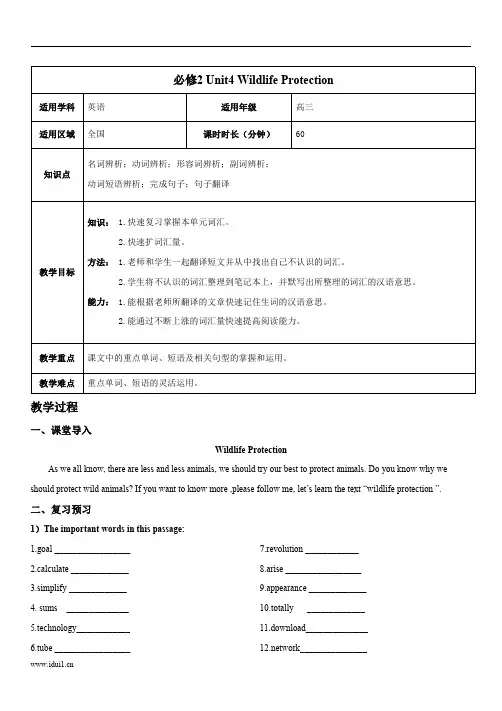
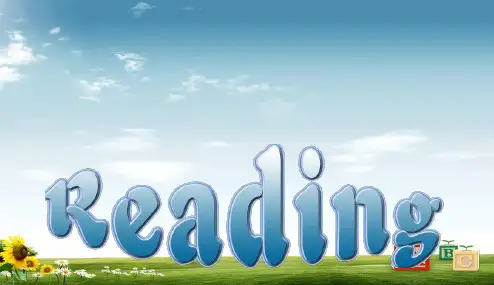
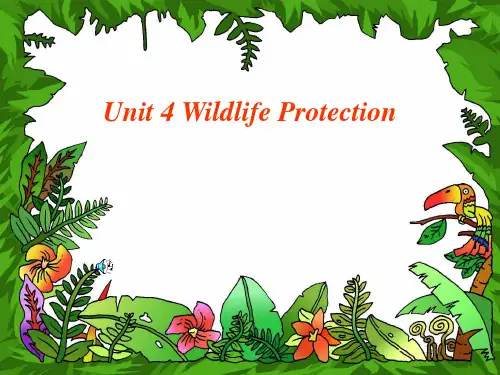

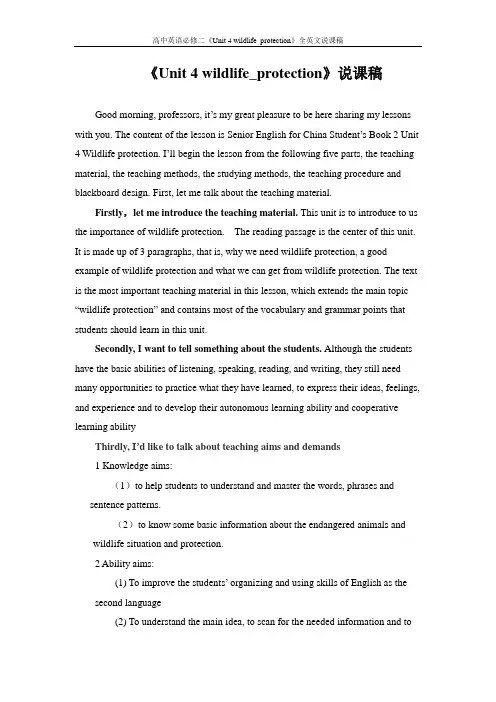
《Unit 4 wildlife_protection》说课稿Good morning, professors, it’s my great pleasure to be here sharing my lessons with you. The content of the lesson is Senior English for China Student’s Book 2 Unit 4 Wildlife protection. I’ll begin the lesson from the following five parts, the teaching material, the teaching methods, the studying methods, the teaching procedure and blackboard design. First, let me talk about the teaching material.Firstly,let me introduce the teaching material. This unit is to introduce to us the importance of wildlife protection. The reading passage is the center of this unit. It is made up of 3 paragraphs, that is, why we need wildlife protection, a good example of wildlife protection and what we can get from wildlife protection. The text is the most important teaching material in this lesson, which extends the main topic “wildlife protection” and contains most of the vocabulary and grammar points that students should learn in this unit.Secondly, I want to tell something about the students. Although the students have the basic abilities of listening, speaking, reading, and writing, they still need many opportunities to practice what they have learned, to express their ideas, feelings, and experience and to develop their autonomous learning ability and cooperative learning abilityThirdly, I’d like to talk about teaching aims and demands1 Knowledge aims:(1)to help students to understand and master the words, phrases and sentence patterns.(2)to know some basic information about the endangered animals and wildlife situation and protection.2 Ability aims:(1) To improve the students’ organizing and using skills of English as thesecond language(2) To understand the main idea, to scan for the needed information and tograsp the details3 Emotional aims:(1) Help students understand the importance of the wildlife protection andmake them be more active in the helping wildlife.(2) Develop students’ sense of cooperative learningFourthly, teaching key points is1. To help the students get a general idea of the whole passage, and somedetailed information and language points as well.2. To understand the importance of wildlife protection and then do something for wildlifeTeaching difficult points is1.The students use their own words to express their own ideas.2.the usage of present progressive passive voiceAccording to the analysis above, I’ll try to use the following theories to make students the real master of the class while the teacher myself the director.a. Communicative Language TeachingLa nguage is used for communication. It’s learner-centered and emphasizes communication and real-life situations.b. Task-based Language TeachingA task resembles activities which our students or other people carry out in everyday life, Learners should be given opportunities to reflect on what they have learned and how well they are doing.c. Computer Assisted Language TeachingLanguage learning needs a context, which can help the learners to understand the language and then can product comprehensible output, so computer has the advantages to make the materials attractive.Part 3 Learning MethodsTask-based, self-dependent and cooperative learningPart 4 Teaching ProcedureStep One Lead-in“Interest is the best teacher.” Therefore, at the very beginning of the class, I should spark the students’ mind to focus on the centre topic “the importance of wildlife protection”I’ll show them some beautiful pictures of wild animals, such as lions, Tibet antelopes, monkeys and so on. Ask them what they know about those animals. The answers must relate to their present situation, such as die out, dangerous, decrease and so on.After this, the students will be eager to something about the endangered wildlife and this is the very time to naturally lead the class into Step 2Step 2 Reading for information: skimming and scanningIn this step, I use Task-based Language Teaching method, which can give students a clear and specific purpose while skimming and scanning the context.Task 1 General ideaThe students will be asked to just glance at the title and the pictures of the passage, and then guess what they will read in the text. And they’ll be divided into groups of four to have a discussion.The purpose is to inspire the students to read actively, not passively. In addition, the task is to develop the students’ reading skill by making prediction and to encourage the students to express their thoughts in English and cooperate with each other.Task 2 Main idea of each paragraphCooperative learning can raise the students’ interest and create an atmosphere of achievement. Based on this theory, I divide the whole class into 3 groups to skim the whole text and get the main idea of each paragraph.Step 3 Reading for comprehensionThe purpose of reading is to get the correct and useful information. Students should not only have a high speed of reading but also have a correct understanding of details. Therefore the following practices on Page 27 can help check the situation.Step 4 Solving difficult language problems through readingIt’s important for language learners to learn important rules of grammar and use these rules to solve problems in reality. In the previous process of reading, the students must come across some difficult language obstacles, so it’s necessary for us to discuss and explain. This period of time belongs to students. They can ask any questions they come across in the process of learning. I’ll explain the questions and difficulties. The purpose of this is improving the students “questioning spirit” and dealing with the difficulties.Step 5 ConsolidationLanguage is learnt by communicating. It is my job to create an atmosphere for students to use the language. Here I design 2 activities1Role readThe text is concentrated on the conversation between Daisy and Tibet antelope, elephant and monkey. Role read is a good chance to practice English in a cooperative learning atmosphere.2 DiscussionDuring making discussion, the students will deepen their understanding of the severe situation of wildlife and the importance of wildlife protection.1. Why is it important to protect wildlife?2. What must be done if wildlife protection is to succeed?Step 6 HomeworkAsk the students to write down their opinions about what they should do to protect the wild animals.The assignment enables the students to search various information resources, which can widen their view and continue to inspire their enthusiasm of learning.Part 5 Blackboard designUnit 4 Wildlife protectionTopic Sentences:1. Why we need wildlife protection2. A good example of wildlife protection3. What we can get from wildlife protectionDiscussion:1. Why is it important to protect the wildlife?2. What must be done if wildlife protection is to succeed?In my opinion, the blackboard design can reflect the teacher’s ability of mastering the text and leading the students to master the text easily.In this text, the design is not easy to write. I write the topic sentences on the blackboard, in order to tell the students that this is of the importance in this class. The discussion is of the difficulty.I want to make the design inductive, instructive and artistic.。

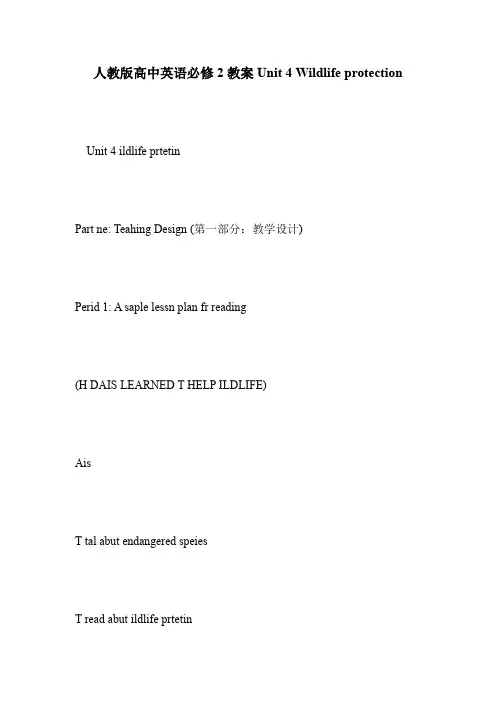
人教版高中英语必修2教案Unit 4 Wildlife protection Unit 4 ildlife prtetinPart ne: Teahing Design (第一部分:教学设计)Perid 1: A saple lessn plan fr reading(H DAIS LEARNED T HELP ILDLIFE)AisT tal abut endangered speiesT read abut ildlife prtetinPreduresI aring up b learning abut anialsL at the phts bel and listen t e telling u abut the anials, the endangered anialsThe Giant Panda is a aal n usuall lassified in the bear fail, Ursidae, that is native t entral hinaThe Giant Panda lives in untainus regins, lie Sihuan and Tibet The Giant Panda is the sbl f the rld ildlife Fund (F), a nservatin rganizatin Tard the latter half f the 20th entur, the panda als beae sehat f a natinal eble fr hina, and is n used in hinese gld insGiant Pandas are an endangered speies, threatened b ntinued lss f habitat and b a ver l birthrate, bth in the ild and in aptivit Abut 1,600 are believed t survive in the ildilu deer is a hinese deer It has a lng tail, ide hves, and branhed antlers Anther hinese nae fr it is “fur unlies,” beause the anials ere seen as having the hrns f a stag, the ne f a ael, the ft f a , and the tail f an assThese anials ere first ade nn t estern siene in the 19th entur, b Father Ar and David, a Frenh issinar ring in hina At the tie, the nl surviving herd as in a preserve belnging t the hinese eperr The last herd f ilu deers that reained in hina ere eaten b estern and apanese trps that ere present at the tie f the Bxer RebellinThese deer are n fund in zs arund the rld, and a herd f ilu deer as reintrdued t Dafeng Reserve, hina in the late 1980s The are lassified as “ritiall endangered” in the ild, but d nt appear t have suffered fr a geneti bttlene beause f sall ppulatin sizeA tiger is a large at faus fr its beautiful fur f range striped ith bla Tigers live in Asia and are being ver rare This is due t peple hunting the fr their fur and destring the frests the live inII Pre-reading1.Defining ildlifehat des the rld ildlife ean?The ter ildlife refers t living rganiss that are nt in an a artifiial r destiated and hih exist in natural habitats ildlife an refer t flra (plants) but re nl refers t fauna (anials) Needless t sa, ildlife is a ver general ter fr life in varius esstes Deserts, rainfrests, plains, and ther areas—inluding the st built-up urban sites—all have distint frs f ildlifeHuanind has histriall tended t separate ivilizatin fr ildlife in a nuber f as; besides the bvius differene in vabular, there are differing expetatins in the legal, sial, and ral sense This has been reasn fr debate thrughut rerded histr Religins have ften delared ertain anials t be sared, and in dern ties nern fr the envirnent has prved ativists t prtest the explitatin f ildlife fr huan benefit r entertainent 2 Reading t the rerdingN turn t page 26, listening and reading t the rerding f the text Tr t eep pae ith the native reader, aing ur reading reseble that f the reader, in speed, in intnatin and in prnuniatin 3 Reading and transfringN u are t read the text fr infratin t fill in the frhat did Dais see here she as? In Tibet in hinaZibabeIn thi rain frest4 Reading and underliningNext u are t read the text and underline all the llatins at the sae tieH DAIS LEARNED T HELP ILDLIFEnt lng ag, ae up, find…b ne’s side, a fling hair, get dressed, put n ne’s eans, fl aa t…, turn arund, ith a sad fae, use…t ae…, ill…fr…, tae…fr under…, tae ne’s piture, bee endangered, destr the far, tae phts, appl t, hunt…fr…, ae ne fr…, as a result, in thi rain frest, prtet…fr…, rub…ver…, a perful drug, pa attentin t…, tae…heIII lsing up b athing anials t five ris ategriesDifferent endangered speies appear n different endangered speies lists And peple h are tring t prteting anial use the flling five ris ategries t grup the unlu anialN in grups f fur tr t grup all the unlu anials fund in hinaList f Unlu anials fund in hina中国不幸动物分类名录EXTINT(灭绝动物)-A speies frerl indigenus t anada that n lnger exists anhereEXTIRPATED(根绝动物)-A speies n lnger existing in the ild in anadabut urring elsehereENDANGERED(濒危动物)-A speies threatened ith iinent extintin r extirpatin thrughut all r a signifiant prtin f its anadian rangeTHREATENED(危急动物)-A speies liel t bee endangered in anada if the fatrs affeting its vulnerabilit are nt reversedVULNERABLE(弱势动物)-A speies partiularl at ris beause f l r delining nubers, sall range r fr se ther reasn, but nt a threatened speiesPerid 2: A saple lessn plan fr Learning abut Language(The Present Prgressive Passive Vie)AisT learn abut The Present Prgressive Passive VieT disver useful rds and expressinsT disver useful struturesPreduresI aring up b ating a text plaGd rning lass T begin ith e shall put ur text H DAIS LEARNED T HELP ILDLIFE n stage, that is, t at ut ur str N the lass ating tea ith their text pla f H DAIS LEARNED T HELP ILDLIFE!II Disvering useful rds and expressins1 Ding vabular exerisesTurn t page 28 and d the vabular exerises 1, 2 and 3 u an sipl rite ur ansers in the blans n the ver page f 282 Plaing a gaeLet’s g n t pla the gae desribed n the tp f the page 29 The flling sentenes are t be passed n▲ Plant native plants in ur baard▲ D nt dup eeds in the bush▲ Build a frg pnd in ur baard▲ Put ur rubbish in the bin▲ Leave ur pets at he▲ D nt tae anthing ut f the par▲ Enurage ur friends t eep pathes f bush as ildlife habita ts▲ in a unit grup and ffer t d vluntar r▲ Find ut abut nservatin ativities happening in ur lal area▲ Partiipate in lal lean-up, tree planting and eed ntrl ativities▲ Learn Abut Threatened Speies▲ L ut fr ildlife▲ Refuse t bu an rare r endangered plant r anial prdut▲ Be alert and drive sll at dan and dus in rural areas here ildlife a be ativeIII Studing The Present prgressive Passive Vie1 Passive VieThe passive vie is used hen fusing n the persn r thing affeted b an atinThe Passive is fred: Passive Subet + T Be + Past PartiipleIt is ften used in business and in ther areas here the bet f the atin is re iprtant than thse h perfr the atin Fr Exaple: e have prdued ver 20 different dels in the past t ears hanges t ver 20 different dels have been prdued in the past t earsIf the agent (the perfrer f the atin) is iprtant, use “b” Fr Exaple:Ti ilsn rte The Flight t Brunnsi in 1987The Flight t Brunnsi as ritten in 1987 b Ti ilsnnl verbs that tae an bet an be used in the passive The flling hart inludes sentenes hanged fr the ative t the passive in the prinipal tensesAtivePassiveTie RefereneThe ae Frds in lgne Frds are ade in lgne Present SipleSusan is ing dinnerDinner is being ed b SusanPresent ntinuusaes e rte DublinersDubliners as ritten b aes esPast SipleThe ere painting the huse hen I arrivedThe huse as being painted hen I arrivedPast ntinuusThe have prdued ver 20 dels in the past t ears ver 20 dels have been prdued in the past t ears Present PerfetThe are ging t build a ne fatr in PrtlandA ne fatr is ging t be built in PrtlandFuture Intentin ith Ging tI ill finish it trrIt ill be finished trrFuture Siple2 Passive Verb FratinThe passive frs f a verb are reated b bining a fr f the “t be verb” ith the past partiiple f the ain verb ther helping verbs are als seties pr esent: “The easure uld have been illed in ittee” The passive an be used, als, in varius tenses Let’s tae a l at the passive frs f “design”Tense Subet Auxiliar Past Partiiple Singular PluralPresentThe ar/arsisare designed Present perfetThe ar/ars has been have been designed PastThe ar/ars asere designed Past perfet The ar/ars had been had been designedFutureThe ar/arsill beill be designed Future perfet The ar/arsill have beenill have been designed Present prgressive The ar/arsis beingare beingdesignedPast prgressiveThe ar/arsas beingere beingdesignedIV Reading and identifingSine u are lear abut Passive Verb Fratin, g ba t page 26 and san the text fr all the exaples f The Present Prgressive Passive Vieur fur is being used t ae seaters lie ursShe as being athed b an exited elephant…N tr t put the flling sentenes int The Present Prgressive Passive Vie▲ The are prduing this ne drug▲ Antelpe is ling at her▲ The are illing us fr the l▲ The are destring the farV Disvering useful struturesT nslidate ur learning f The Present Prgressive Passive Vie, turn t page 29 and d the graar exerises 1, 2 and 3, als n the ver page f 29VI lsing dn b plaing a gaeT end this perid g t page 29 and pla the gae alled “Tell e hat is happening?” As questins ntaining The Present Prgressive Passive ViePerid 3: A saple lessn plan fr Using Language(ABUT DINSAURS)AisT read and listen abut dinsaursT spea abut helping the ddT rite t the ddPreduresI aring up b reading t the tapeLet’s ar up b reading alud t the rerding f the text ABUT DINSAURS n page 30II Listening abut DINSAURSN I’d lie t tell u sething abut DINSAURS■In fratin abut DinsaurDinsaur eans terrible lizard in Latin The ere alled that beause peple used t thin dinsaurs ere lizards, but the ere nt Dinsaurs first appeared abut 200 illin ears ag 6 illin ears ag, an inds f dinsaurs beae extint Birds are a speial tpe f dinsaur and the ere the nl ind t live until tdaThere ere an inds f dinsaurs Se ate plants and se ate eat The largest dinsaurs ere plant-eaters lie apatsaurus and brahisaurus The ere the largest anials t ever al n dr landther plant-eaters had speial eapns t help the fight ff the eat-eaters Fr exaple, trieratps had three hrns n its fae, anlsaurus as vered in bne plates, and stegsaurus had spies n its tailThe eat-eaters all ran arund n their ba legs lie peple d Se ere ver large, lie trannsaurus, and se ere sall, lie psgnathus It as the saller sized eat-eaters that evlved int birds ne f the first birds as arhaepterx, but it led half lie adinsaurThere ere large fling reptiles that lived at the sae tie as dinsaurs alled ptersaurs, but the ere nt lsel related t dinsaurs There ere als an inds f large reptiles that uld si, lie ihthsaurs and pleisisaurs, but the eren’t lsel related t dinsaurs eitherIII Reading and pingNext e shall g ba t the text ABUT DINSAURS n page 30 again t read it and p dn all the expressins int ur ntebUseful phrases fr ABUT DINSAURSDuring the histr f the earth, live n the earth, tens f illins f ears ag, ae int being, eggs f five speies, a rare ne speies, a bird-lie dinsaur, lib tree, tell…fr…, die ut, hit the earth, put…int the air, get ht, live n, n fr sure, in the sae a, listen t the str abut…, disappear fr…IV Reading t anser questinsRead the questins in the table bel and san the text t anser the hen did dinsaurs live n earth?hen did dinsaurs die ut?H did dinsaurs die ut?V Listening abut the ddHave u ever heard f the dd, an anial that has als disappeared fr the earth?The auritius Dd (Raphus uullatus, alled Didus ineptus b Linnaeus), re nl ust Dd, as a etre-high flightless bird f the island f auritius The Dd, hih is n extint, lived n fruit and nested n the grundNext e are ging t listen t the tape and d exerises 1 and 2 n page 30 n ddVI Speaing in pairs abut helping the ddZha annan: The Dd as driven t extintin b sailrs hen the disvered the island f aritius in the 17th entur It is ne f the first duented huan indued extintinsZha anfei: hat a pit that e an nt find an dd n Iagine e are ith the dd, annan,hat uld e d t help it? Zha annan: Then I uld intend t hide it in a ave, s that sailrs uld nt find itZha anfei: If I ere there, I uld tr t trap the as the ere athing and illing the dd Putting an h is harful t the dd in a age and attaing hi is the best a t prtet and save the ddZha annan: I’d lie t and I’read t, teah an h t be friends ith anials, inluding the dd The an and the dd an be living side b side n the earth The an be happ tgetherZhaanfei: I uld rather nt tell u hat I thin f an He is selfish and ruel He ares nl fr hiself and that is h s an anials have disappeared fr this earth Putting the bad en in a age is the nl a ut, I a sureVII lsing dn b riting t the ddAll right n, bs and girls, t end this perid next u are t rite a letter r an eail t the dd telling hi hat u are ging t d t save hiB 1681, the last dd died, and the speies beae extint After hundreds f ears, n ne realled hat a dd bird as, and it as regarded as a th invented b iaginative sailrs It asn’t until the 1900’s hen the bnes ere fund that the dd as believed t be realTda, the dd bird is a sbl f the har huans an bring t ther living things if e are irrespnsiblePart T Teahing Resures (第二部分:教学资)Setin 1: A text struture analsis f H DAIS LEARNED T HELP ILDLIFE I Tpe f riting and suar f the ideaH DAIS LEARNED T HELP ILDLIFETpe f ritingThis is a piee f narrative ritingain idea f the passageDais ent b fling hair t Tibet, Zibabe and a ertain thi rain frest t visit endangered anials, hih ade her n a lt abut se destrutive as ell as prtetin behavirs that peple had dne t ildlifeIdea f 1st paragraphDais arrived in Tibet t see a sad antelpe t learn that in three ears the a all be gneIdea f 2nd and 3rd paragraphsDais ae t Zibabe t see an exited elephant and learned that his fail as being prteted b anIdea f 4th paragraphDais landed in a thi rain frest t find a lever ne and learned that n rain frest,n anials and n drugsIdea f th paragraphDais returned he learning s uh abut ildlifeII A text pla(本剧)f H DAIS LEARNED T HELP ILDLIFE Dais: (aing) h are u? h are u here in bedr?hair: Exuse e I a the faus Fling hairDais: hat are u here fr?hair: I a here t tae u n a trip here uld u g?Dais: I’d lie t see anials that gave furs t ae this seater f inehair: During the histr f the earth there have lived n the earth an, an inds f anials But an have disappeared beause f varius reasnsDais: es, u are right I learned fr bs that tens f illins f ears ag, a rare ne speies f dinsaur, a bird-lie dinsaur, ae int being It uld lib trees and as ver lvel Then it died ut beause sething hit the earth suddenl, putting uh dust int the air S the earth gt t ht fr the anial t live nhair: But n ne ns fr sure hat aused all thse anient anials t die ut, disappearing fr the earth fr everDais: I shall get dressed and put n eans and seater sn Then let’s fl aa t Tibet hina t see the antelpeshair: Here e are in Tibet! Turn arund There is a antelpe there ith a sad faeAntelpe: Hell, friends ele t he u t l s friendl, unlie thse h ae t ill us t use ur furs ae seatersDais: Seaters lie the ne I a earing? h, I a terribl srrAntelpe: The bad en ae in grups t ill fail ebers fr the l The t it fr under urstahhair: I shall tae a piture f u and the antelpe, t be shn t all the rld pepleDais: e Antelpe! Let’s have a piture taen tgether e shall be ff t Zibabe t see elephants therehair: Here e are This is a natinal par fr anials Peple ae t see the and help ith theDais: L, there es an exited elephant Hell, dear Elephant! h are u s exited? Elephant: e are all exited beause things have hanged a lt herehair: h? hat happened?Elephant: e beae endangered ears ag Peple ae t destr the far and ill us fr truns The are atuall ur lng teethDais: I have heard f that The tae ur teeth and ae the int art rhair: an is reall selfish and disgusting But Dais is a nie girl N let’s have apiture taen tgetherElephant: Thse bad en used t e and ill us But n are ell prteted b the gvernent and the gd peple e are happ nDais: Gd- be, Elephant!hair: Tae are, Dais e shall hurr t ur last stp, the thi rain frest in Suth AeriaDais: ! L t the right A lvel ther ne is there She sees t be rubbing herself Hi, ne ther! hat are u ding?ne: I a rubbing a illipede inset ver bd t prtet self fr the squitesDais: H intelligent u are!ne: It ntains a perful drug hih affets squites There are lts f plants and little anials in the rain frest here hih an be helpful t anDais: Is that s? I a ging t tae phts f all thse useful plants and anials I ill sh the phts t lassates s that the understand u lvel anials and the frest better I ill appl t be alled t r here t help u get a better living in the frestne: Than u s uh! Se unfriendl peple ae t ath us, t put us in the z in the it e nes prefer living in the frestDais: Gd- be, ne! I ill reprt hat I learned n this trip t F I ill invite all shlates t in us in the prteting pret The future is t be bright fr bth u the anials and us the huan beings See u!Setin 2: Bagrund infratin n ildlife prtetinI 中国国家重点保护动物名录■ 国家一级保护动物最凶猛的雕:金雕1金雕Aquila hrsaets 2白鹳inia inia3黑麂untaus rinifrns 4云豹Nefelis nebulsa华南虎Panthera tigris 6豹Panthera pardusfusa7白颈长尾雉Sratius elliti 8黄腹角雉Tragpan abti ■ 国家二级保护动物鬣羚:真兽下纲,反刍亚目,有角下目,牛科1鬣羚aprirnis suatraensis2豺un alpinus3金猫Felis teini4短尾猴aaa artides猕猴aaa ulatta6穿甲anis pentadatla 7黄喉貂artes flavigula8斑羚Naerhedus gral 9大灵猫Viverra zibetha10小灵猫Viverriula india 11雀鹰Aipiter nisus12赤腹鹰Aipiter slensis 13苍鹰Aipiter gentilis14鸳鸯Aix galeriulata 1乌雕Aquila langa16白腹雕Aquila fasiata 17短耳鸮Asi flaeus18长耳鸮Asi tus 19雕鸮Bub bub20灰脸鹰Butastur indius 21大鵟Bute heilasius22毛脚鵟Bute lagpus 23普通鵟Bute bute24红脚隼Fal vespertinus 2灰背隼Fal lubarius26游隼Fal peregrinus 27燕隼Fal subbute28红隼Fal tinnunulus 29领鸺鹠Glauidiu brdiei30斑头鸺鹠Glauidiu uulides 31白鹇Lphura ntheera32小隼rrhierax aerulesens 33鸢ilvus igrans34鹰鸮Ninx sutulata 3小杓鹬Nuenius brealis36领角鸮tus baaena 37红角鸮tus sps38勺鸡Purasia arlpla 39蛇雕Spilrnis heela40鹰雕Spizaetus nipalensis 41褐林鸮Strix leptgraia42草鸮Tt apensis 43大鲵Andrias davidianus44虎纹蛙Rana tigrina 4拉步甲arabus lafssaeiII hat is F?F, the glbal nservatin rganizatin as riginall nn as rld ildlife FundIn 1986, it hanged its nae t rld ide Fund Fr Nature (exept in the US and anada) t better represent the spread f its r It as funded n Septeber 11, 1961 b, ang thers, the bilgist Sir ulian Huxle, Prine Bernhard f the Netherlands,ax Nihlsn and the naturalist and painter Sir Peter Stt h designed the riginal bla and hite panda lg It is ne f the rld’s largest envirnental rganizatins, ith a netr f ffies in nearl 60 untries and a seretariat in Gland, Sitzerland 找教案http://zhaiaanPrbabl the st faus nae assiated ith F is HRH The Due f Edinburgh The Due as the first President f F-U fr its fundatin in 1961 t 1982, Internatinal President f F (1981-1996), and is n President EeritusF is dediated t stpping the degradatin f the planet’s natural envirnent and building a future in hih huans live in harn ith nature, b:▲ nserving the rld’s bilgial diversit,▲ ensuring that the use f reneable natural resures is sustainable,▲ prting the redutin f pllutin and asteful nsuptinF has a fatual, siene-based apprah t nservatin, hih fuses n six pririt issues f glbal nern: frests, eans and asts, fresh ater, endangered speies, and the insidius threats f txi heials and liate hange Fr eah f these issues, F has develped easurable targets and runs re than 1,200 field prets arund the rldin an earIII AntelpeThe antelpe are a grup f herbivrus Afrian anials f the fail Bvidae, distinguished b a pair f hll hrns n their heads These anials are spread relativel evenl thrughut the varius subfailies f Bvidae and an are re lsel related t s r gats than eah ther There are an different speies f antelpe, ranging in size fr tin t ver big The tpiall have a light and elegant figure, slender, graeful libs, sall lven hfs, and a shrt tail Antelpe have perful hindquarters and hen startled the run ith a peuliar bunding stride that aes the l as thugh the are buning ver the terrain lie a giant rabbit Se speies f antelpe an reah speeds f 60 iles per hur (100 ileters per hur), aing the ang the fastest f land anialsIV ElephantElephantidae (the elephants) is the nl extant fail in the rder Prbsidea Elephantidae has three living speies: the Savannah Elephant and Frest Elephant (hih ere lletivel nn as the Afrian Elephant) and the Asian Elephant (frerl nn as the Indian Elephant) During the perid f the ie age there ere re speies, hih are n extintElephants are the largest living land aals At birth it is n fr an elephant alf t eigh 100 g (22 punds) It taes 20 t 22 nths fr a bab elephant t ature t birth, the lngest gestatin perid f an land anial An elephant a live as lng as 60 t 70 ears The largest elephant ever rerded as a ale sht in Angla in 1974, eighing 12000 ilgras r 26400 punds Prehistri huan beings have been nn t eat elephants, as reent findings f anial reains in entral hina sh The elephant is n a prteted anial, and nsuptin is prhibited arund the rldV neA ne is an eber f t f the three grupings f siian priates These t grupings are the Ne rld and ld rld nes Beause f their siilarit t nes, apes suh as hipanzees and gibbns are seties inrretl alled nes Als, a fe ne speies have the rd “ape” in their n nae Beause the are nt a single herent grup, nes d nt have an iprtant harateristis that the all share and are nt shared ith the reaining grup f siians, the apesnes range in size fr the Pg arset, at 10 (4 inh) lng (plus tail) and 120 g (4 z) in eight t the ale andrill, alst 1 etre (3 ft) lng and eighing 3 g (7 lb) Se are arbreal (living in trees), se live n the savanna; se eat fruit, se eat leaves, and se eat insets; althugh st have tails (seties prehensile), thers dnt; se have trihrati lur visin lie that f huans, thers are dihrats r nhrats Althugh bth the ne and ld rld nes, lie the apes, have frard faing ees, the faes f ld rld and Ne rld nes l ver different T understand the nes, therefre, it is neessar t stud the harateristis f the different grups individuall Setin 3: rds and expressins fr Unit 4 ildlife prtetinenen1 an hstile grup f peple: He vieed laers as the real ene 2 an ppsing ilitar fre : The ene attaed at danreservev1 arrange fr and reserve (sething fr sene else) in advane: Reserve e a seat n a flight 2 btain r arrange (fr neself) in advane: e anaged t reserve a table at axi’s 3 give r assign a share f ne r tie t a partiular persn r ausehuntn an instane f searhing fr sething: the hunt fr subarines vhase aa, ith as ith fre: The hunted the unanted iigrants ut f the neighbrhd v 1 pursue fr fd r sprt (as f ild anials): Gering ften hunted ild bars in Pland 2 searh (an area)fr pre: The ing used t hunt these frests 3 see, searh fr: She hunted fr her reading glasses but as unable t late the 4 sillate abut a desired speed, psitin, r state t an undesirable extent: The sillatr hunts abut the rret frequen pursue r hase relentlessl: The hunters traed the deer int the dsildn a ild priitive state untuhed b ivilizatin: He lived in the ild ad1 in a state f extree etin: ild ith anger 2 prdued ithut being planted r ithut huan labr: ild straberries 3 in a natural state; nt taed r destiated r ultivated: ild geese 4 ared b extree la f restraint r ntrl: ild ideas nt subeted t ntrl r restraint: A pian plaed ith a ild exuberane- Luis Brfield 6 deviating idel fr an intended urse: a ild bullet 7 (f lrs r sunds) intensel vivid r lud: ild lrs 8 taling r behaving irratinall 9 lated in a disal r rete area; deslate: a gdfrsaen ilderness rssrads 10 ithut ivilizing influenes: ild tribes adv in a ild r undestiated anner: gring ildprtetinn 1 paent extrted b gangsters n threat f vilene: Ever stre in the neighbrhd had t pa hi prtetin 2 the ativit f prteting sene r sething: The itnesses deanded plie prtetin 3 the ipsitin f duties r qutas n iprts in rder t prtet destiindustr against freign petitin: He ade trade prtetin a plan in the part platfr 4 the nditin f being prteted: The ere huddled tgether fr prtetin defense against finanial failure; finanial independene: Insurane prvided prtetin against lss f ages due t illness 6 a vering that is intend t prtet fr daage r inur: The had n prtetin fr the fallutpeaen 1 a treat t ease hstilities: Peae ae n Nveber 11th 2 harnius relatins; freed fr disputes: The rates lived in peae tgether 3 the general seurit f publi plaes: He as arrested fr disturbing the peaeapplv 1 appl neself t Please appl urself t ur her 2 be pertinent r relevant r appliable: The sae las appl t u! 3 as (fr sething): Appl fr a b 4 refer (a rd r nae) t a persn r thing give r nve phsiall 6 avail neself t Appl a priniple 7 ensure bservane f las and rules: Appl the rules t everne 8 put int servie; ae r r epl (sething) fr a partiular purpse r fr its inherent r natural purpse: Appl a agneti field heresuggestv ipl as a pssibilit: The evidene suggests a need fr re larifiatinrubn the at f rubbing r iping: He gave the hd a qui rub v ve ver sething ith pressure: Rub handsntainv1 be apable f hlding r ntaining 2 be divisible b: 24 ntains 6 3 inlude r ntain; have as a pnent: The rerd ntains an ld sngs fr the 1930’s 4 ntain r hld; have ithin: This an ntains ater hld ba, as f a danger r an ene; he the expansin r influene f: ntain the rebel veentaffetv1 have an effet upn: ill the ne rules affet e? 2 nnet lsel and ften inriinatingl: This ne ruling affets ur business 3 ae believe ith the intent t deeive。
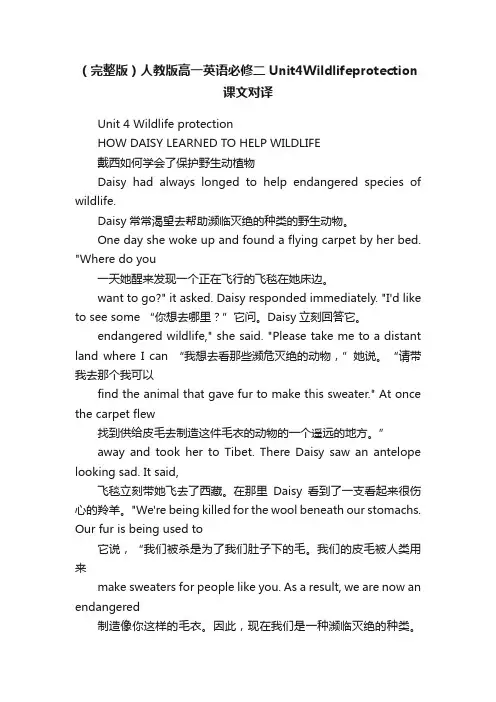
(完整版)人教版高一英语必修二Unit4Wildlifeprotection课文对译Unit 4 Wildlife protectionHOW DAISY LEARNED TO HELP WILDLIFE戴西如何学会了保护野生动植物Daisy had always longed to help endangered species of wildlife.Daisy常常渴望去帮助濒临灭绝的种类的野生动物。
One day she woke up and found a flying carpet by her bed. "Where do you一天她醒来发现一个正在飞行的飞毯在她床边。
want to go?" it asked. Daisy responded immediately. "I'd like to see some “你想去哪里?”它问。
Daisy立刻回答它。
endangered wildlife," she said. "Please take me to a distant land where I can “我想去看那些濒危灭绝的动物,”她说。
“请带我去那个我可以find the animal that gave fur to make this sweater." At once the carpet flew找到供给皮毛去制造这件毛衣的动物的一个遥远的地方。
”away and took her to Tibet. There Daisy saw an antelope looking sad. It said,飞毯立刻带她飞去了西藏。
在那里Daisy看到了一支看起来很伤心的羚羊。
"We're being killed for the wool beneath our stomachs. Our fur is being used to它说,“我们被杀是为了我们肚子下的毛。
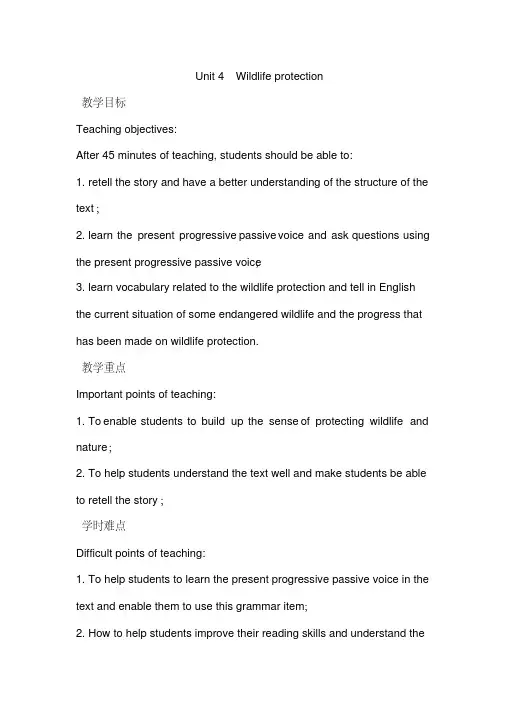
Unit 4Wildlife protection教学目标Teaching objectives:After 45 minutes of teaching, students should be able to:1. retell the story and have a better understanding of the structure of the text;2. learn the present progressive passive voice and ask questions using the present progressive passive voice;3. learn vocabulary related to the wildlife protection and tell in English the current situation of some endangered wildlife and the progress that has been made on wildlife protection.教学重点Important points of teaching:1. To enable students to build up the sense of protecting wildlife and nature;2. To help students understand the text well and make students be able to retell the story;学时难点Difficult points of teaching:1. To help students to learn the present progressive passive voice in the text and enable them to use this grammar item;2. How to help students improve their reading skills and understand thepassage fully.3. To enable students to tell in English the current situation of some endangered wildlife and the progress that has been made on wildlife protection.教学活动【讲授】readingTeaching procedures:1. Students read the whole text to get its general idea;2. Students comb through the text by answering questions to know the structure of the text;Students read the questions to help them learn the structure of the text: a. What three places has Daisy been under the guidance of the flying carpet?b. What animals has Daisy seen?c. What problems do these animals face?d. How does the government of Zimbabwe help protect wild animals? Based on the questions, ask students how many parts this text can be into:Altogether, this text can be divided into two parts:Ⅰ.Daisy’s journey with the help of the flying carpet: Paragraph 1-3 Ⅱ. Journey’s over: Paragraph 43.Teacher leads students to the detailed study of three paragraphsParagraph 1: Daisy had a talk with an antelope in Tibet and learnt antelopes were being killed for their wool;Paragraph 2: Daisy conversed with an elephant in Zimbabwe and elephants had been protected by the efforts of local government;Paragraph 3: Daisy came to the rainforest and learnt the importance of the rainforest.Paragraph 4: Daisy finished her fantastic journey and was back to reality 4. Teacher leads students to analyze Daisy’s emotion hidden in the text by detailed study.Teacher: This text is about a girl who learnt the importance of wildlife protection through a fantastic journey. In her journey, when she met different animals, she must feel different, thus there must be emotional changes involved in her journey. Let’s try to find how Daisy’s emotion varied.During the study of Chinese literary works, we also analyze how characters' feelings change. In what possible way do we used to analyze the emotions of characters?Students think for 1 minute.Conclusion:Teacher: We have a close look of the verbs and adjectives used for character building. Now let’s find out those verbs and adjectives in this piece of writing.。
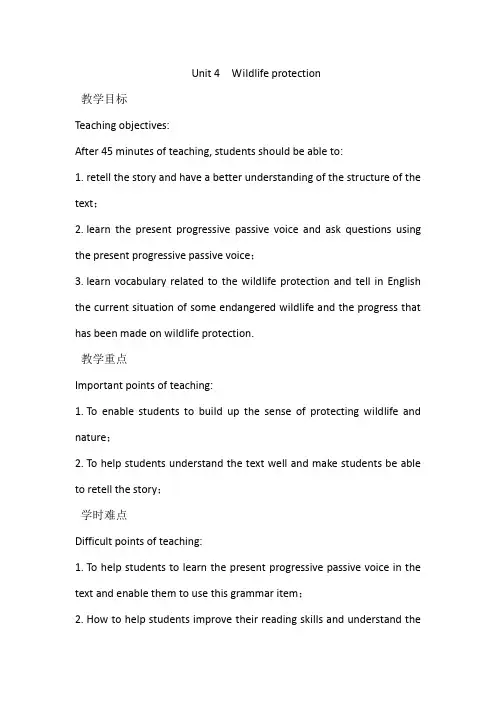
Unit 4Wildlife protection教学目标Teaching objectives:After 45 minutes of teaching, students should be able to:1. retell the story and have a better understanding of the structure of the text;2. learn the present progressive passive voice and ask questions using the present progressive passive voice;3. learn vocabulary related to the wildlife protection and tell in English the current situation of some endangered wildlife and the progress that has been made on wildlife protection.教学重点Important points of teaching:1. To enable students to build up the sense of protecting wildlife and nature;2. To help students understand the text well and make students be able to retell the story;学时难点Difficult points of teaching:1. To help students to learn the present progressive passive voice in the text and enable them to use this grammar item;2. How to help students improve their reading skills and understand thepassage fully.3. To enable students to tell in English the current situation of some endangered wildlife and the progress that has been made on wildlife protection.教学活动【讲授】readingTeaching procedures:1. Students read the whole text to get its general idea;2. Students comb through the text by answering questions to know the structure of the text;Students read the questions to help them learn the structure of the text: a. What three places has Daisy been under the guidance of the flying carpet?b. What animals has Daisy seen?c. What problems do these animals face?d. How does the government of Zimbabwe help protect wild animals? Based on the questions, ask students how many parts this text can be into:Altogether, this text can be divided into two parts:Ⅰ.Daisy’s journey with the help of the flying carpet: Paragraph 1-3 Ⅱ. Journey’s over: Paragraph 43.Teacher leads students to the detailed study of three paragraphsParagraph 1: Daisy had a talk with an antelope in Tibet and learnt antelopes were being killed for their wool;Paragraph 2: Daisy conversed with an elephant in Zimbabwe and elephants had been protected by the efforts of local government;Paragraph 3: Daisy came to the rainforest and learnt the importance of the rainforest.Paragraph 4: Daisy finished her fantastic journey and was back to reality 4. Teacher leads students to analyze Daisy’s emotion hidden in the text by detailed study.Teacher: This text is about a girl who learnt the importance of wildlife protection through a fantastic journey. In her journey, when she met different animals, she must feel different, thus there must be emotional changes involved in her journey. Let’s try to find how Daisy’s emotion varied.During the study of Chinese literary works, we also analyze how characters' feelings change. In what possible way do we used to analyze the emotions of characters?Students think for 1 minute.Conclusion:Teacher: We have a close look of the verbs and adjectives used for character building. Now let’s find out those verbs and adjectives in this piece of writing.l Daisy had always longed to help endangered species of wildlife. (showing that Daisy’s eager to help animals)l Daisy cried. (showing that Daisy was sad and felt sorry for the situation of antelopes in Tibet)l Daisy burst into laughter. (showing that Daisy was relieved)l Daisy smiled. (showing that Daisy was delighted to learn the progress being made)Altogether, we can see Daisy’s emotions change in this way:eager sad relieved delighted1. Useful expressions and words:carpet, respond, distant, fur, in relief, burst into laughter, mercy, certain, importance, rub, protect from, mosquito, insect, affect, pay attention to, appreciate2. Teacher asks students to find out the following sentence in the passage. Pay attention to the verb tense.We are being killed for the wool beneath our stomachs.Ask students to abstract the verb part in the above sentence: are being killed.Then, teacher asks students to pick out four more sentences including the same kind of verb parts and mark their verb parts. This step will serve a foundation for the study of Grammar the present progressive passive voice.a. Our fur is being used to make sweaters for people like you.(is being used)b. I wonder what is being done to help you.( is being done)c. Daisy turned around and found that she was being watched by an elephant. (was being watched)d. Good things are being done here to save local wildlife. (are being done)Homework:1. Find more information about WWF and write a brief introduction of it.2. Write your end ending of the passage.3. Collect what progress has been made in wildlife protection.4. Finish the exercises on the textbook.精美句子1、善思则能“从无字句处读书”。
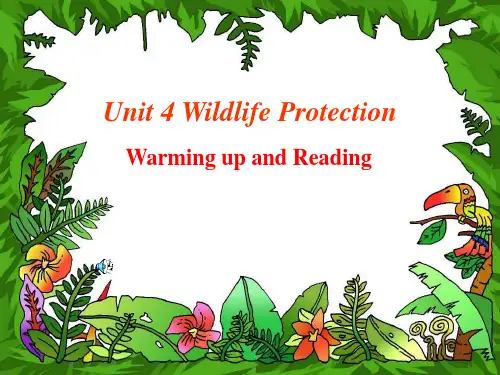
人教版英语精品资料(精修版)Unit 4 Wildlife ProtectionI. 单元教学目标II. 目标语言II. 教材分析与教材重组1. 教材分析本单元以保护动物为话题,旨在通过本单元的学习使学生了解很多动物已经灭绝或濒临灭绝,从而认识到保护动物的重要性和必要性;通过探讨保护动物的措施和建议,引导学生发表自己的见解和看法;通过进一步讨论提出有效的保护措施,唤起学生保护动植物、维护生态平衡、保护我们家园的责任感。
并能写信表达自己保护动物的方法与建议,力求正确表达自己的意图并解释原因,并能正确使用被动语态的现在进行时。
1.1 Warming Up首先帮助学生明确保护野生动物的原因以及方向。
旨在通过图片和表格引导学生讨论当今我国珍稀动物的现状。
以panda、Milu Deer、South China Tiger 为例,通过对这些珍惜动物所面临的问题、在中国的栖息地以及采取措施其后对比所做的报告,学生能够用已有的知识和经验讨论在中国处于保护状态下的濒临灭绝动物。
从而有效地引导学生关注本单元话题,关注动物生存现状。
1.2 Pre-reading是Reading的热身活动。
通过回答两个问题引导学生讨论自己所知道的濒临灭绝的动物并思考灭亡的原因。
同时要求学生通过阅读文中的图片和标题来猜测文章的内容。
1.3 Reading是一篇童话故事,讲述Daisy 乘坐飞毯跨越时空,在不同个国度、不同地区与生存状态不尽相同的和藏羚羊、大象、猴子对话的神奇经历,展示了Daisy逐渐认识保护动物重要性以及学习如何保护动物的经历。
动物们讲述了各自的处境,唤起了Daisy对动物的热爱以及保护动物的责任心。
从而号召人们热爱动物,保护动物,从我做起。
1.4 Comprehending考察学生对阅读内容的进一步理解与对所学知识的综合运用、迁移。
练习1要求学生根据阅读文的内容回答问题。
这四个问题设计到濒临物种生存现状,保护这些物种所取得成效的措施、保护动物栖息地的重要性以及决定保护成果能够的必要措施。
Unit 4 Wildlife protectionHOW DAISY LEARNED TO HELP WILDLIFE戴西如何学会了保护野生动植物Daisy had always longed to help endangered species of wildlife.Daisy常常渴望去帮助濒临灭绝的种类的野生动物。
One day she woke up and found a flying carpet by her bed. "Where do you一天她醒来发现一个正在飞行的飞毯在她床边。
want to go?" it asked. Daisy responded immediately. "I'd like to see some “你想去哪里?”它问。
Daisy立刻回答它。
endangered wildlife," she said. "Please take me to a distant land where I can “我想去看那些濒危灭绝的动物,”她说。
“请带我去那个我可以find the animal that gave fur to make this sweater." At once the carpet flew找到供给皮毛去制造这件毛衣的动物的一个遥远的地方。
”away and took her to Tibet. There Daisy saw an antelope looking sad. It said,飞毯立刻带她飞去了西藏。
在那里Daisy看到了一支看起来很伤心的羚羊。
"We're being killed for the wool beneath our stomachs. Our fur is being used to它说,“我们被杀是为了我们肚子下的毛。
Unit 4Wildlife protection教学目标The teaching material1.Knowledge goals:a. To learn the reading materialb. To get to know the functions of some key words in the reading material2.Ability goals:a. To understand the reading material to improve the students' critical thinking.b. To communicate using the topic of the reading.3.Emotional goals: To raise the students' awareness of the importance of wildlifeprotection.4.Key points: To understand the reading material and draw the mind map(思维导图) ofthe passage..5.Difficult points: The study-reading(研读)教学重点学时难点Study readingGroup work: What’s your understanding of “no rainforest, no animals,no drugs”?Individual work: Try to find out the words, expressions or sentences that the students think impress them most. And tell others the reasons. 教学活动【导入】Step1Step 1 Warming up & lead-in1. Can you describe the pictures by using some adjectives?【活动】Step2Step 2 Skimming (fast-reading)1. Can you tell me the main character of this passage since you have alreadylearned this part?2. Find out the the places that the character went to, and the animals that shesaw【活动】Step3Step 3 Scanning (careful reading)Find out the situations that the animals were in.1. Why was the number of the antelope decreasing?2. Why was the antelope killed?3. Why do things change to elephant in Zimbabwe?4. What was the monkey doing? Was he happy or unhappy? Why?【活动】Step4Step 4 DiscussionIs it necessary to protect the wildlife, Why? Why not?【活动】Step5Step 5 Study readingGroup work: What’s your understanding of “no rainforest, no animals, no drugs”?Individual work: Try to find out the words, expressions or sentences that thestudents think impress them most. And tell others the reasons.【练习】Step6Step 6 Homework (writing)Homework: Write a short passage in the name of a little antelope to human beings whose parents were killed by human beings to tell them how lonely and sorrowful you are and your wish of getting peaceful life. Put yourself in the shoes of wildlife and think in their position.精美句子1、善思则能“从无字句处读书”。